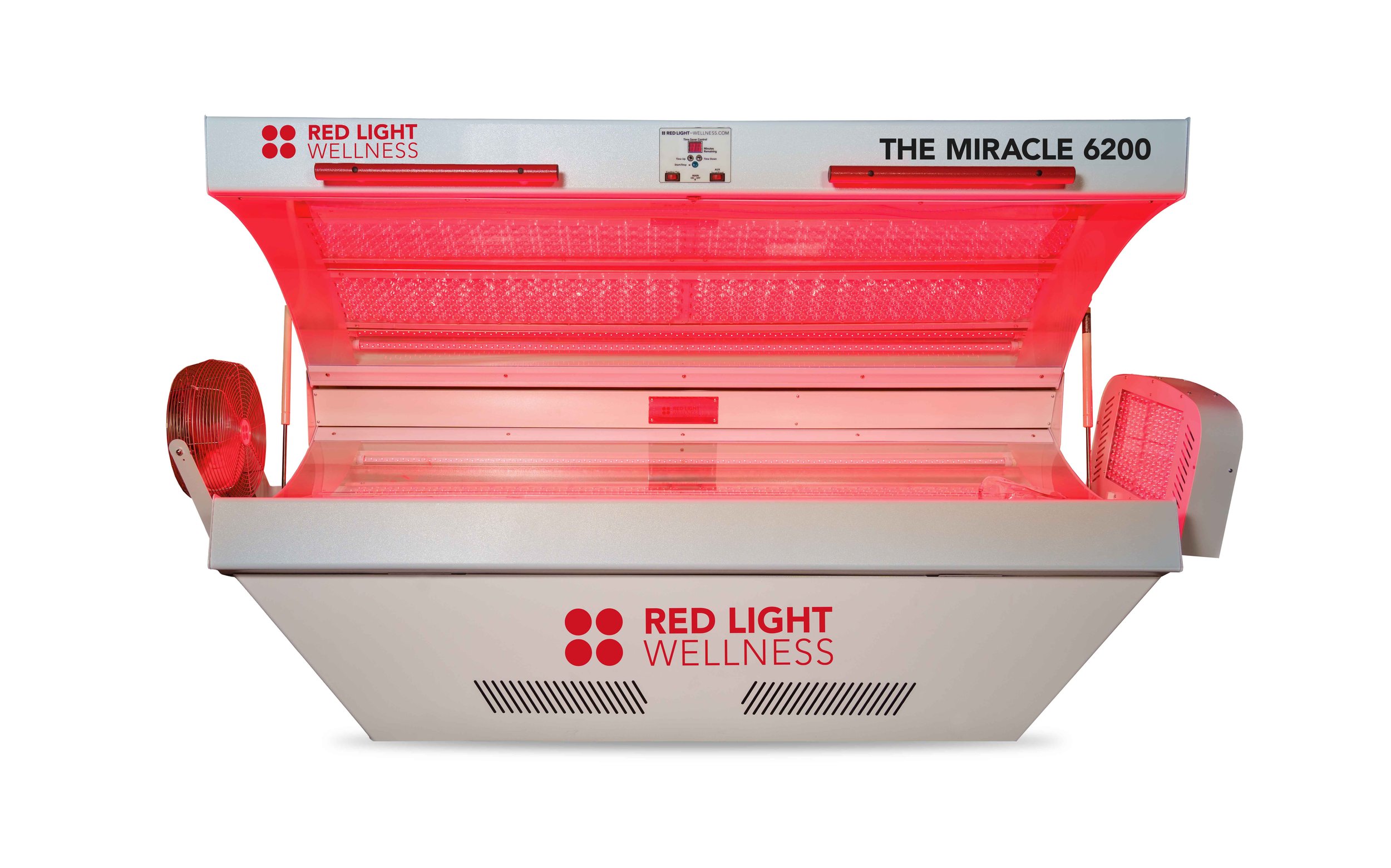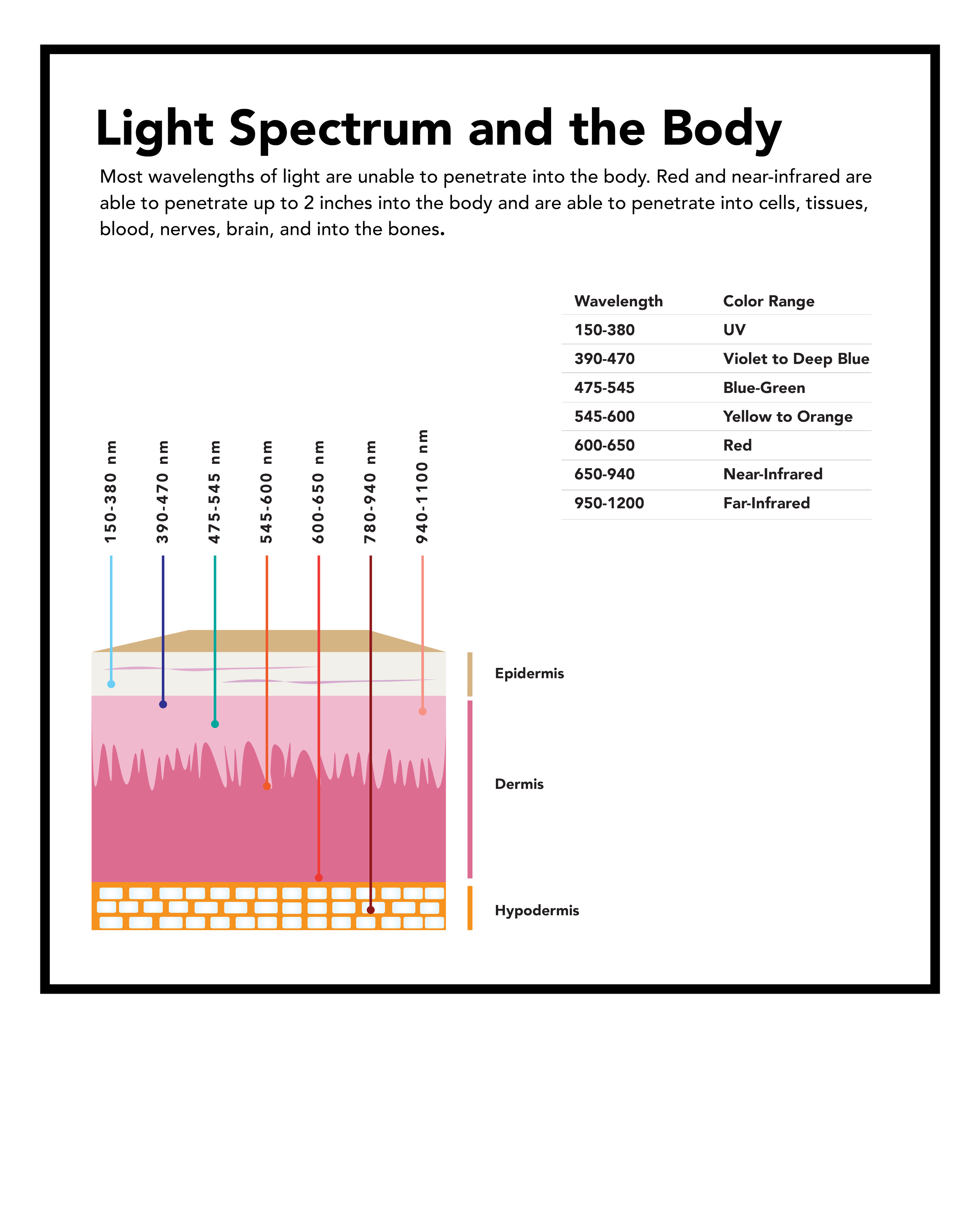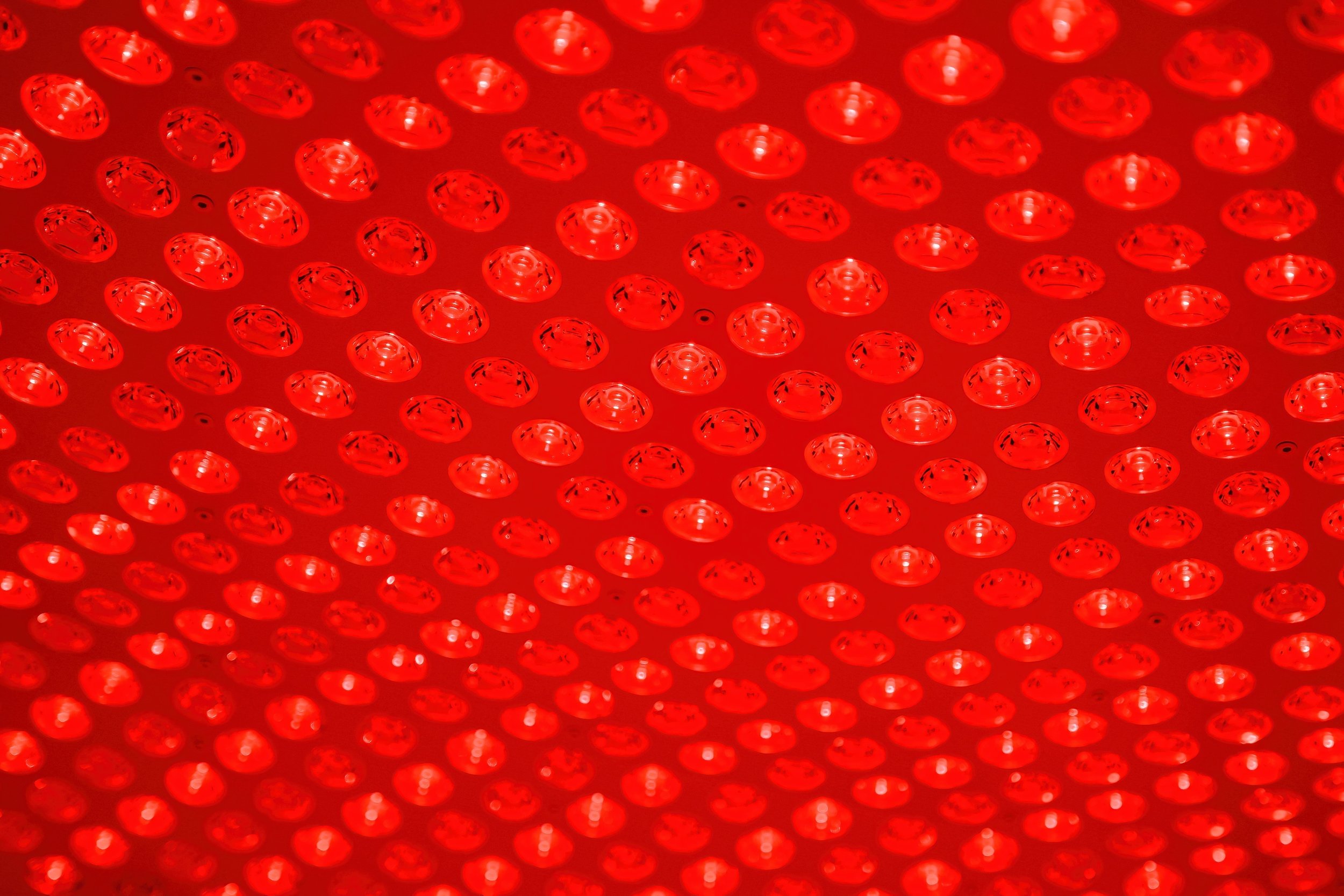Red Light Therapy
Red Light Therapy (RLT) has gained significant popularity as a non-invasive treatment for various health and wellness applications. Let’s explores how RLT works, the conditions it targets, its safety, and what to consider when using it.
What Is Red Light Therapy
When you expose your entire body to red and near-infrared light, a part of your cells called the mitochondria, or the “powerhouse” of your cells, soak it up and make more energy, also known as ATP (adenosine triphosphate). By increasing the function of the mitochondria using Red Light Wellness, a cell can make more ATP. With more energy, cells can function more efficiently, rejuvenate themselves, and repair damage.
Red and near-infrared light occupy the “long end” of the visible spectrum with wavelengths of 630nm-940nm. Red and near-infrared light is effective for use on the skin's surface and can penetrate up to two inches into the body affecting the cells, tissues, blood, nerves, the brain, and bone.
Check out the news and the latest info on our blog.
How Did Interest in Red Light Therapy Evolve?
Interest in red light therapy initially surged due to NASA's experiments with LED light to support plant growth in space. Researchers noticed potential wound healing and tissue repair effects, prompting further studies. This has recently given rise to several forms of light emmitting diode therapy (LEDT) modalities. Since then, various studies have examined its impact on skin health, muscle recovery, and even mental wellness.
The History of Red Light Therapy
People have used light as a therapy since the beginning of time. Ancient Egypt, India, and Greece erected temples for healing light therapies. In medieval times, Florence Nightingale, who, in the 1850s, advocated the use of clean air and an abundance of sunlight to restore health, began the modern renaissance in ‘light as therapy.’
It was not until much later, in 1962, that Nick Holonyak invented and demonstrated the first semiconductor laser diode that emitted visible red light while working at General Electric.
That same year, Endre Mester at the Semmelweis Medical University in Hungary tried to replicate an experiment performed by Paul McGuff of Boston, who had used a high-powered ruby laser to cure malignant tumors in rats. Much to Mester’s discovery, he inadvertently made a much lower-powered laser, and the tumors that had been implanted into the rats were not affected by his low-powered laser, and it seemed the experiment had failed.
But before closing the research book on this failed attempt he did observe something very interesting. He observed that where he had shaved and implanted the tumors in the rats and applied his lower-powered laser the rate of healing of the incisions and the hair growth was much faster than normal. This was the first discovery that low-level laser light could have its own beneficial applications in medicine.
Though this was a great discovery on the part of Endre Mester, many did not believe this low-level laser therapy produced any real therapeutic benefits to the body. It was not until 1989 that Tiina Karu wrote a paper that was instrumental in understanding how this low-level laser therapy, also known as red light therapy and photobiomodulation, worked. She discovered that the therapy works through the mitochondria. When shining red light therapy on the tissue, the cytochrome c oxidase enzyme in the mitochondria absorbs this light, and the various mechanisms that cascade afterward to the organisms are astounding. The brain gets more blood flow, our cells get more energy, genes and stem cells activate left and right.
In 1995, NASA funded Quantum Devices Inc. to complete an LED plant-growth unit that grew potatoes on the space shuttle. Once in space, astronauts who spent time working with their hands under these LED lights found that abrasions on their hands healed much faster. NASA then brought the technology back down from space and started researching its biological effects on humans. Combining Tiina's research and NASA's continued studies with human candidates and the therapy's validity, this is how the industry of red light therapy emerged. There are now thousands of studies on the effects of red light therapy on the various mechanisms of the human body.
For What Skin Conditions is Red Light Therapy Being Tried?
Red Light Therapy is popular for various skin conditions, including:
Anti-Aging: Red light is known to stimulate collagen production, which can improve skin elasticity and reduce wrinkles.
Acne Treatment: By reducing inflammation and potentially reducing acne-causing bacteria, red light can be beneficial for mild to moderate acne.
Psoriasis and Eczema: RLT may help alleviate symptoms in some people, possibly due to its anti-inflammatory properties.
Is Red Light Therapy Effective?
The effectiveness of red light therapy varies depending on the condition being treated, the device used, and the frequency of sessions. Clinical studies indicate positive outcomes for pain relief, skin rejuvenation, and muscle recovery, though individual experiences vary. More long-term studies are needed to solidify its effectiveness for other uses.
Is Red Light Therapy Safe?
Red light therapy is generally considered safe, especially when protective measures are taken for the eyes, as prolonged exposure to high-intensity red or NIR light can cause eye strain or potential damage. Following device instructions regarding exposure time and distance can help minimize any risks.
What Other Medical Conditions is Red Light Therapy Being Promoted For?
Beyond skin health, red light therapy is also being explored for various other conditions:
Muscle Recovery and Joint Pain: RLT can aid muscle recovery and reduce soreness, making it popular among athletes.
Mental Health: Some users report relief from symptoms of depression and anxiety, though more research is needed to substantiate these claims.
Arthritis and Chronic Pain: Red light’s anti-inflammatory effects have shown promise for people dealing with chronic pain, including arthritis sufferers.
Key Factors in Choosing Red Light Therapy Devices
Many different devices on the market offer the therapeutic benefits of red light therapy. There are face masks, wraps, pads, blankets, panels, hats, whole-body beds, and more to choose from. Smaller devices are easy to use, affordable, and offer healing light, but business owners should try to steer away from devices that the average person can buy online.
It’s important for business owners to use medical-grade, professional devices that use proven therapeutic wavelengths. Research shows that most therapeutic wavelengths that achieve real results are 630-680nm - 800-880nm. Having the right wavelengths is not all you need to look at but also the irradiance of the devices. Check out our e-book to learn more about choosing the right red light therapy device for your business.
What Else Do I Need to Know About Red Light Therapy?
Regulatory Approvals
While certain devices are FDA-cleared for specific uses, others may lack rigorous testing. Always look for reputable brands with regulatory approval for the safest experience.
Contraindications
People with photosensitivity disorders or those taking photosensitizing medications should consult a healthcare provider before starting red light therapy, as it may aggravate sensitivity issues.
References
For more scientific information, please refer to peer-reviewed studies and clinical research on PubMed or medical journals. The American Academy of Dermatology also provides guidelines on safe light therapy practices for skin care. As the technology and studies are advancing we at Red Light Wellness, are doing our best to educate and provide resources about red light therapy.
Doctor-recommended, medical-grade, full-body red light therapy beds are available for clinical settings, fitness and wellness centers, and home use.
The Wellness Collection
-

The Miracle 5040
-

The Miracle 6200
-

The Big Miracle 7200
-

The Max Miracle 9600













